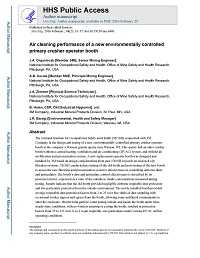Mining Publication: Air Cleaning Performance of a New Environmentally Controlled Primary Crusher Operator Booth
Original creation date: February 2016
The National Institute for Occupational Safety and Health (NIOSH) cooperated with 3M Company in the design and testing of a new environmentally controlled primary crusher operator booth at the company’s Wausau granite quarry near Wausau, WI. This quarry had an older crusher booth without a central heating, ventilation and air conditioning (HVAC) system, and without an air filtration and pressurization system. A new replacement operator booth was designed and installed by 3M based on design considerations from past NIOSH research on enclosed cab filtration systems. NIOSH conducted pre-testing of the old booth and post-testing of the new booth to assess the new filtration and pressurization system’s effectiveness in controlling airborne dusts and particulates. The booth’s dust and particulate control effectiveness is described by its protection factor, expressed as a ratio of the outside to inside concentrations measured during testing. Results indicate that the old booth provided negligible airborne respirable dust protection and low particulate protection from the outside environment. The newly installed booth provided average respirable dust protection factors from 2 to 25 over five shifts of dust sampling with occasional worker ingress and egress from the booth, allowing some unfiltered contaminants to enter the enclosure. Shorter-term particle count testing outside and inside the booth under near-steady-state conditions, with no workers entering or exiting the booth, resulted in protection factors from 35 to 127 on 0.3- to 1.0-μm respirable size particulates under various HVAC airflow operating conditions.
Authors: JA Organiscak, AB Cecala, JA Zimmer, D Tholen, JR Baregi
Peer Reviewed Journal Article - February 2016
NIOSHTIC2 Number: 20047770
Min Eng 2016 Feb; 68(2):31-37
See Also
- Dust Considerations When Using Belt Entry Air to Ventilate Work Areas
- The Effects of Water Spray Placement for Controlling Respirable Dust and Face Methane Concentrations
- Equivalency of a Personal Dust Monitor to the Current United States Coal Mine Respirable Dust Sampler
- Investigation of Coal Properties and Airborne Respirable Dust Generation
- Laboratory Evaluation of Pressure Differential-based Respirable Dust Detector Tube
- Laboratory Testing To Quantify Dust Entrainment During Shield Advance
- Maximizing Air Quality Inside Enclosed Cabs with a Unidirectional Filtration and Pressurization System
- New Tools To Monitor Personal Exposure To Respirable Coal Mine Dust
- Performance of a Light Scattering Dust Monitor at Various Air Velocities: Results of Sampling in the Active Versus the Passive Mode
- Relationship of Coal Seam Parameters and Airborne Respirable Dust at Longwalls
- Content source: National Institute for Occupational Safety and Health, Mining Program


 ShareCompartir
ShareCompartir
